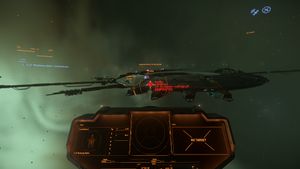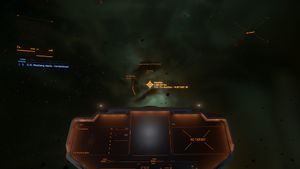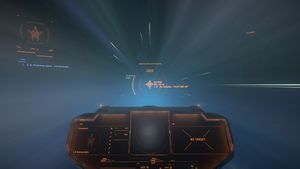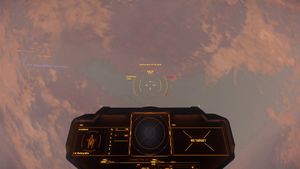Guide : Quantum Travel
Equipment considerations, minimum requirements.

Ships require a quantum drive in order to traverse the vast interplanetary distances in star systems. While some vehicles are not capable of quantum travel (such as the Argo MPUV and Kruger P-Series ), the vast majority of spacefaring ships do come factory-equipped with a quantum drive.

Quantum drive specifications

Not all quantum drives perform identically. Three major considerations should be made when choosing a drive for your ship:
Size classification
Each quantum drive falls into one of three size classes: Size 1, Size 2, and Size 3. Consult your mobiGlas Vehicle Loadout Manager app to determine your ship's quantum drive size class. You cannot install a quantum drive of a different size class than the one required by your ship.
Cruise speed
Quantum cruise speeds are measured in meters per second (m/s), but may also be listed in megameters per second (Mm/s) for better readability (1 megameter = 1,000 kilometers = 1,000,000 meters). Alternatively, cruise speeds may also be listed as a fraction of light speed (c). Current quantum drive manufacturers offer drives with cruise speeds anywhere from 53.6 Mm/s (0.18 c) to 283 Mm/s (0.94 c).
Fuel consumption
Quantum drives require quantum fuel to operate. As a general rule, there is a tradeoff between cruise speeds and fuel consumption. If you wish to extend the maximum range of your ship, it may be worthwhile to invest in a slower quantum drive. Conversely, if you wish to reach your destinations faster, you may be willing to expend more fuel to do so.
Route planning
Before taking off, familiarize yourself with the journey you wish to embark upon by consulting the Starmap application on your mobiGlas.
- Zoom in and out with the mouse scroll wheel
- Double right-click to zoom all the way out to the system overview
- Rotate your view by clicking and holding down the left mouse button
- Pan your view by clicking and holding down the right mouse button
- To recenter the map on your current position, click the button with a circle surrounded by a target reticle, found at the top of the screen
When you're ready to plot a trip:
- Select a destination by clicking directly on it
- To plot a trip to the selected destination, click the "Set Route" button at the top
- To clear a currently plotted trip, click the "Clear Route" button at the top
Your quantum drive can only make straight-line jumps. As such, you may be required to make multiple quantum jumps in order to reach your destination.
Ad hoc destination selection
Not all quantum jumps require the use of a plotted starmap course. Pilots may also choose their destination by spooling up the quantum drive without a selected destination and aiming the ship at their destination marker. Markers come in various shapes to distinguish the type of location they represent:
Starmap interface

The information box at the top left displays important data relevant to your currently plotted journey:
- Current quantum fuel on board of your ship
- Required quantum fuel to complete the plotted journey
- A progress indicator, listing all the waypoints in the journey
- A time enroute indicator (the small white number at the bottom right of the information box), which indicates the journey time in seconds
Once you are satisfied with the parameters of your journey, you may close your starmap application. The plotted journey will be synchronized with your ship's on-board computer.
Before takeoff
Ensure you have enough quantum fuel on board your ship to reach your destination or a refueling facility. To refuel your ship while parked on a landing pad, call up your mobiGlas Vehicle Maintenance Services app, select "Refuel Quantum" on the right side of the screen, click "Confirm", and monitor the refueling progress on your ship's HUD.
Preparing for the jump

Quantum jumps cannot be made through solid objects. Your ship's on-board computer generally recognizes obstructions and will prevent the execution of a jump. Nonetheless, verify your ship is clear of any obstacles before commencing your journey. Failure to do so may result in ship damage and destruction, as well as loss of life and property aboard.
Arrival considerations
You may wish to disable IFCS cruise mode before beginning your journey. If left enabled, your ship will automatically accelerate after exiting the quantum jump. This could lead to a collision if you arrive in front of an obstacle such as a space station or asteroid.
Point your ship directly at the first waypoint marker, which will be displayed on your HUD. Please be aware that this waypoint may be behind you.
Spool and calibrate

The following conditions must be met before your ship can begin the quantum jump:
- Sufficient fuel to reach the next waypoint
- Next waypoint is not obstructed
- Quantum drive spooled at 100%
- Calibration at 100%
- Cooldown phase completed
- No active quantum enforcement device in the vicinity
Once all the conditions for a successful launch have been achieved, you may engage your quantum drive. By default, this can be done by pressing and holding the B key until the ship begins its journey.

Your ship's autopilot will manage the jump once it begins and drop you out at your waypoint or destination by itself.
Should you require to make an emergency stop during your quantum jump, you may do so by switching off your ship's engines (default key: I ).

Your quantum drive automatically enters a cooldown phase after arriving at your waypoint or destination. During this time, you may spool and calibrate your quantum drive in preparation for the next leg of your journey, but you will not be able to engage your quantum drive until the cooldown phase has been completed.
To continue on your multi-waypoint journey, repeat the steps as listed above, beginning with "Preparing for the jump".
Happy journeys!
Star Citizen Wiki
Welcome to the wiki! Be sure to read the rules before editing, and if you have any questions or confusions, feel free to contact us!

- Single star systems
- Not implemented content
- Article stubs

Nexus system
- View history
Nexus system is a single star system that has a white dwarf in its center orbited by five planets and has three jump points .
- 4 Travel information
- 5.1 Stellar objects
- 5.2 Space stations
- 8 Patch history
- 9 References
History [ ]
Discovered back in 2445 (present day: 2945) by Dominic Thapa, a UEE pilot, the first jump point to Nexus was located in Cathcart. At the time, that system was under strict military control and off limits to the public, so naturally, the same applied to Nexus. Initiall scans of Nexus IV revealed a healthy ammount of minerals located there, so the military decided to move in and began the terraforming process on Nexus IV and III, which was to be the headquarter for military forces in this system. Attempts were made to terraform Nexus II as well, because of its unique Nitrogen atmosphere. However, none of these showed any lasting results. Because of this failure, and the immense monetary strains caused by terraforming the other two planets at the same time, in 2468, the government decided to sell the entire system to the Hathor group in order to raise funds and also keep public traffic through Cathcart to a minimum.
Politics [ ]
Economy [ ], travel information [ ], planets [ ].
The Red God
Stellar objects [ ]
Elcibre Belt
Space stations [ ]
Gallery [ ].

See also [ ]
- Galactic Guide: Nexus system
- List of star systems
Patch history [ ]
References [ ].
- Star Citizen
- 3 List of armors and undersuits
Is it safe to look at a total solar eclipse? What to know about glasses, proper viewing
If you have your eyewear to take in monday's eclipse, here are some last-minute things to consider to ensure you're good to go..

The much-anticipated solar eclipse will finally enshroud thousands of miles of North America today in its long, narrow shadow. By now, those who plan to witness it should have their plans in place .
Travel has been completed. Schedules have been coordinated around the anticipated moment of totality. And proper eyewear is, of course, in your possession. Right?
We at USA TODAY have published no shortage of articles guiding you away from scam eclipse glasses and to the safest, most reliable options – some of which were even free. But if you need a last-minute refresher – or a crash course to catch you up on a topic you entirely missed – we're happy to oblige.
If you don't have your eclipse glasses by now, it may be too late. But some vendors, including Warby Parker , and even public libraries, have offered eclipse glasses giveaways , so be sure to check your local area before the historic event rolls into town.
And if you do have your eyewear to take in Monday's eclipse – the last one of these incredible astronomical events in North America for 20 years – here are some last-minute things to consider to ensure you're in good shape.
Solar eclipse 2024 live updates: See latest weather forecast, what time it hits your area
Can you go blind by looking at the solar eclipse?
Staring at the sun is unlikely to completely blind you , but its powerful rays can still burn and damage your retinas if you don't take proper safety precautions to view solar eclipses .
That's why eyewear is recommended if you plan to look up at the sun Monday to witness the solar eclipse, which most of the country will be able to experience in some way.
In the face of the sun's powerful rays, regular sunglasses made of cheap plastic and polycarbonate material just aren't going to cut it. Astronomers and other experts instead emphasize that skygazers intent on viewing the upcoming total solar eclipse do so with specialized eyewear crafted to protect their sensitive retinas from permanent damage.
Even viewing any part of the bright sun through camera lenses, binoculars and telescopes without a specialized solar filter could instantly cause severe eye injury , according to the American Astronomical Society.
Often made with a polyester film coated in aluminum, the glasses are highly specialized . Compared to regular sunglasses, proper eclipse glasses are 100,000 times darker to block nearly all visible, infrared and ultraviolet light and protect our sensitive retinas when looking skyward.
As another point of safety, don't look up while driving , please.
How to know when it's safe to view the eclipse without glasses
A total solar eclipse offers the unique opportunity for skygazers to witness the spectacular astral display with the naked eye – but only when the time is right.
Hundreds of cities in 13 states are along the path of totality for the eclipse, which will move across North America from southwest to northeast . When the moon moves completely in front of the sun and blocks its light for a brief period of time, you'll know it's safe to fully take in the dazzling display.
That moment is what is called "totality," whereby uncharacteristic darkness falls and all but the sun's outermost layer known as its corona makes a rare appearance to us here on Earth, according to NASA .
How to make sure your eclipse glasses aren't fake
In the rush to acquire some coveted eclipse glasses before April 8 , you may have inadvertently fallen victim to the fakes and imitators proliferating online retailers .
While plenty of legitimate certified eyewear was widely available – and may still be – less-scrupulous manufacturers try all sorts of methods and tricks to get your attention and make you believe the product you're about to buy is the real deal.
For instance, many vendors began making the grand (and entirely made-up) claim that their products are endorsed by NASA.
As the space agency reiterated to USA TODAY , NASA highly recommended that skygazers get a pair of certified eclipse glasses before the total solar eclipse charts a 115-mile-wide path of totality blanketing much of North America in uncharacteristic darkness . But it does not approve any particular brand of solar viewers, despite what many vendors may claim.
The responsibility of guiding American consumers to the safest eclipse glasses is largely left to the American Astronomical Society.
The organization maintains a curated list of approved vendors of solar eclipse glasses that it updated to give priority to North American manufacturers ahead of the total solar eclipse. Products you purchase that are listed on that site are guaranteed to be in compliance with the highest international safety standards.
Those standards are set by the International Organization for Standardization, which only vouches for solar eclipse glasses that are dark and strong enough to filter out a certain amount of the sun's harmful light.
The astronomical society also provides some helpful tips for how to spot counterfeit glasses.
No eclipse glasses? Welding lenses, pinhole projectors among alternative viewers
While certified solar eclipse glasses are the preferred method for viewing the eclipse, alternative methods do exist that don't necessarily sacrifice one's safety.
Many people, particularly blue-collar workers, may be tempted to turn to those welding lenses they have sitting in their workshop.
But beware: The most common welding goggles and helmets aren't typically strong enough to adequately withstand the sun's powerful rays and protect your vulnerable eyes.
Any welding lenses weaker than a Shade 12 filter – a number that indicates the level of protection offered – just aren't going to cut it when it comes to gazing upward in anticipation of the moon blocking all but the sun's outermost layer.
It's also not too late to buy some welding lenses, which Tractor Supply is promoting for sale at its 282 stores along the path of totality as a viable option for viewing the eclipse.
Another simple method is to create your own pinhole projector to project the sun onto a nearby surface. The American Astronomical Society offers helpful instructions to set them up.
And one final note: As you make your eclipse-viewing plans, these interactive maps should help you chart the time and duration for when totality would occur in cities along the path.
Eric Lagatta covers breaking and trending news for USA TODAY. Reach him at [email protected]

IMAGES
VIDEO
COMMENTS
Example of a system ()Planetary systems, usually simply referred to as 'systems', are gravitationally bound collections of orbitally organized planets, planetoids and asteroids around a governing star or group of stars.The gravitational stress of the central objects allows the formation of Jump Points between systems, which allow near-instantaneous interstellar travel.
Right now, there is only the Stanton system. Work is mostly done on Pyro but it's not accessible yet. In the lore, and the longer-term game, travel from one system to another is through wormholes called Jump Points. Just Stanton,m currently. Hopefully the next system the end of this year or early 2023. Then thats 2 systems down 98 to go.
A Star Citizen player has jumped to a new system for the first time. Cloud Imperium Games has tested a key piece of its universe tech that lets players travel between servers and star systems with ...
In terms of traveling from one side of the galaxy to the other side, you have to travel in system, go to a jump point, know that the jump point goes to the other system, make the jump, and then in the next system, fly to the next jump point you want to go through, and so on and so on. Alright, I hope that helps. 10FTC Episode 17 Question 1.
Quantum Travel is the method by which players of Star Citizen navigate the vast distances between planetary bodies in the Verse, whether you are traveling to an Outpost on the surface of Yela to pick up questionable materials or meeting a friend at the M&V bar in Lorville, your ship's Quantum Drive will help you travel around the Verse.
The way travel between systems works in the Star Citizen universe is by flying into natural wormholes stabilized by Jump Gates. Technically, each system is handled by a different server, and now the handoff of players between servers has been tested and is functional.
Without jump points, inter-system travel would be close to impossible. Even at 0.2c achievable with quantum drives, ships would take decades or more to reach a new star system. There are multiple sizes of jump points; the size of the jump point corresponds with the maximum size of a ship able to travel through it. Formation and structure
#starcitizen #tutorial #howto Star Citizen 3.17.4 | How to fly your ship and Basic Navigation Guide - A Beginners TutorialTonight I show you how to get your ...
For a list of ships, see Category:Ships. Ships require a quantum drive in order to traverse the vast interplanetary distances in star systems. While some vehicles are not capable of quantum travel (such as the Argo MPUV and Kruger P-Series ), the vast majority of spacefaring ships do come factory-equipped with a quantum drive.
The universe is a big place, that's where your ship's Quantum Drive comes in. This tutorial will have you traversing the expanses of space in no time. Watch the Tutorial. The Miracle of Flight. In this tutorial, you'll get to know your ship and its systems a little better, learn how to maneuver, and bring her in for the perfect landing.
This Galactic Guide originally appeared in Jump Point 5.11.. E ver since Nick Croshaw first successfully transited a jump point, scientists have studied and theorized the phenomena that makes such inter-system travel possible. For years, the prevailing belief was that the gravitational pull from a star combines with some yet-to-be identified circumstances to create these expressways through space.
Basically, you'll be "loading" during QT. Even if you could travel at 0.2c, if the nearest system is 20 light years, that's 80 years travel time. Also, there's no guarantee the "jump star map" is even correct spatially - it's probably going to be arranged by jump point connection in a way that's easiest to view.
A Jump Point is a natural space-time anomaly, or wormhole, that connects through interspace to other systems, allowing near instant travel between them. Without them, Faster-than-Light (FTL) travel would be impossible. Any efforts to get to other systems would take decades, if not centuries, even with 'Quantum Drives' that can accelerate to 0.2c (20% the Speed of Light). All known ...
For more info, the 23ish minutes was traveling edge to edge of Stanton. I may be mis remembering, but I believe I worked out 7 or 8 AU per minute based on the Star map size of Stanton. I just can't access Stanton size to the 23 minute time ATM. This means other systems (one of which is over 400AU wide) will take considerable longer time.
#StarCitizen #BeginnersGuideThis is Guide #6 in my 10 part Star Citizen Beginner's Guide teaching you everything you need to know to leave your starter plane...
Like space, many of Star Citizen's landing zones are vast and sprawling, and so it can be impossible to fully explore them on foot. At major landing zones, such as the city of Lorville on Hurston, transit systems provide convenient transport between the many points of interest available once landed.. Lorville Mass Transit System (Click to enlarge)
The name "Solar System" is the proper name of our star system, based on the name of the sun as a star ("Sol"). Saying "Solar System" is akin to saying the "Alpha Centari System", or the "Wolf 359 System". All of them, including our own, are star systems. 1.
From memory, it is about 5-7 AU, 1 AU being from the sun to the earth, which is tiny for a gas giant, and most systems will be about 10-20 AU in radius. ok thats good. just in the 3.0 demo they showed at gamescon, it only took them 20 seconds to get to dalamar.. so i was afraid it wouldnt take as long.
Learn how to set a waypoint and then use the Quantum Drive to travel to it.Recorded in the Star Citizen Persistent Universe in an Aegis Dynamics Gladius, whi...
Nexus system is a single star system that has a white dwarf in its center orbited by five planets and has three jump points. Discovered back in 2445 (present day: 2945) by Dominic Thapa, a UEE pilot, the first jump point to Nexus was located in Cathcart. At the time, that system was under strict military control and off limits to the public, so naturally, the same applied to Nexus. Initiall ...
Roberts Space Industries is the official go-to website for all news about Star Citizen and Squadron 42. It also hosts the online store for game items and merch, as well as all the community tools used by our fans. ... Star Citizen gives you unlimited run of the Stanton system, a vast sandbox of life-size planets, moons, cities, space stations ...
In our tenth episode, Archivist Cherie Heiberg and Writer Adam Wieser from the CIG Lore Team explore the Terra System, center of the United Earth Empire.----...
In the face of the sun's powerful rays, regular sunglasses made of cheap plastic and polycarbonate material just aren't going to cut it. Astronomers and other experts instead emphasize that ...
I think you're thinking of Elite Dangerous with Hutton Orbital, which is a troll station put in by the devs. Takes about an hour to fly to but missions there pay out well, due to the real time it takes to travel there. Star Citizen will take at most, with the worst parts equipped and the farthest distance considered, 10-15 minutes.